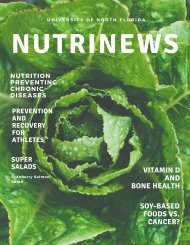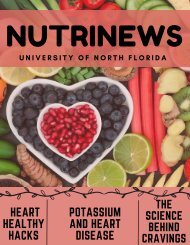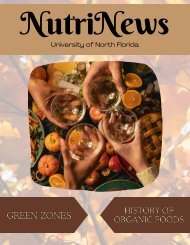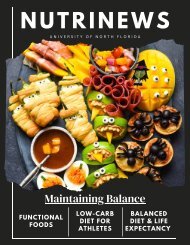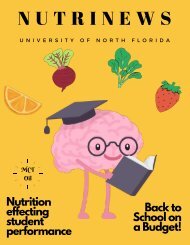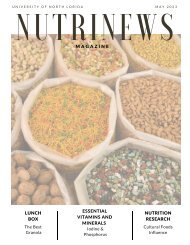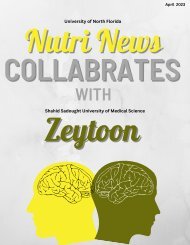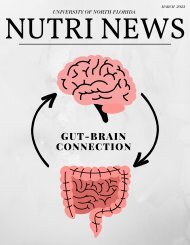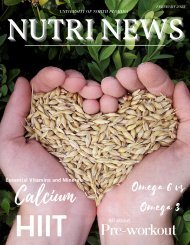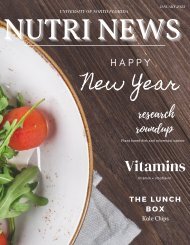May Issue 2024
As Mother's Day draws near, this month's issue of NutriNews delves into the vital topic of nutrition during pregnancy. With a focus on both maternal well-being and fetal health throughout the articles. Within these pages, you'll discover nutrient requirements and recommendations, along with monthly hacks to support expecting mothers on their journey.
As Mother's Day draws near, this month's issue of NutriNews delves into the vital topic of nutrition during pregnancy. With a focus on both maternal well-being and fetal health throughout the articles. Within these pages, you'll discover nutrient requirements and recommendations, along with monthly hacks to support expecting mothers on their journey.
Create successful ePaper yourself
Turn your PDF publications into a flip-book with our unique Google optimized e-Paper software.
Mother’s<br />
Day Recipes<br />
with easy-to-follow,<br />
step-by-step instructions!<br />
Lunch Box Focus:<br />
Iron, B12, and Folate!<br />
CLOSING<br />
REMARKS FROM<br />
NUTRINEWS’<br />
GRADUATING<br />
SENIORS<br />
SPECIAL FEATURE<br />
Vitamins & Minerals:<br />
Prenatal Health<br />
Edition
Table of Contents<br />
“ N A T U R E D O E S N O T H U R R Y , Y E T E V E R Y T H I N G I S<br />
A C C O M P L I S H E D . ”<br />
-Lao TZU<br />
NUTRITION RESEARCH<br />
Nutrient Needs During Pregnancy<br />
WOMEN’S GESTATIONAL HEALTH<br />
Understanding Prenatal Vitamins and Nutrients 06<br />
SENIOR FAREWELLS<br />
Advice and Memories from our Graduating Seniors<br />
10<br />
THE LUNCH BOX<br />
Creamy Chicken and Spinach 13<br />
FETAL NUTRITION<br />
The Impacts of Nutrition on Fetal Health<br />
STAFF SPOTLIGHT<br />
Dr. Labyak 20<br />
MYTH BUSTING<br />
Eating for Two<br />
05<br />
16<br />
23<br />
MONTHLY HACKS<br />
For Pregnancy Nutrition 26<br />
VOLUNTEERS NEEDED FOR RESEARCH<br />
UNF Nutrition Department is Looking for Participants<br />
30<br />
NUTRINEWS STAFF<br />
Get to Know Our Staff!! 31
NUTRITION RESEARCH<br />
DISCUSSING NUTRIENT NEEDS DURING PREGNANCY +<br />
NUTRIENTS’ ROLES IN MATERNAL HEALTH<br />
Ensuring adequate nutrition during<br />
pregnancy is essential to facilitating the<br />
child's growth and maintaining the parent’s<br />
health. Nutrition's role in pregnancy can also<br />
determine the chances of the offspring<br />
developing chronic diseases later in life.1<br />
The Academy of Nutrition and Dietetics<br />
proposes four general components of a<br />
healthy pregnancy: “appropriate weight gain,<br />
regular exercise, appropriate and timely<br />
vitamin and mineral use, and a balanced<br />
diet.”2 Generally, a balanced diet involves a<br />
variety of nutrient- dense foods, such as<br />
fruits, vegetables, healthy fats, whole grains,<br />
and legumes. Some important nutrients to<br />
highlight that are present in these food<br />
groups are folate, calcium, vitamin D, protein,<br />
and choline.<br />
It is recommended that pregnant women<br />
consume 1,000 milligrams of calcium per<br />
day.3 Calcium is well known for<br />
improving and maintaining bone and<br />
teeth health. However, it is also<br />
important for lesser- known functions<br />
like supporting “circulatory, muscular,<br />
and nervous system” functions. Dairy<br />
products are an excellent source of<br />
bioavailable calcium. Other good sources<br />
of calcium include broccoli and kale, as<br />
well as fruit juices and cereals that are<br />
fortified with calcium.3<br />
Folate or folic acid is recommended in<br />
600- 1,000 micrograms daily throughout<br />
pregnancy.3 Folate is a B vitamin that<br />
substantially decreases the risk of fetuses<br />
developing detrimental problems in the<br />
brain and spinal cord. Good sources of<br />
folate are dark leafy greens, “citrus fruits,<br />
dried beans, peas, and lentils.” Fortified<br />
cereals are great sources of folic acid.3<br />
5
WRITER | MADI CASHMAN<br />
WOMEN’S HEALTH<br />
UNF NUTRINEWS<br />
MAY <strong>2024</strong><br />
GESTATIONAL GUIDANCE:<br />
Understanding Prenatal Vitamins and Nutrients<br />
6
PREGNANCY, VITAMINS,<br />
AND NUTRIENTS<br />
Pregnancy is a journey made up of countless changes,<br />
both for the mother and her child. Among the<br />
adjustments and considerations that need to be made,<br />
ensuring proper nutrition stands very high up for a<br />
healthy pregnancy. This is why prenatal vitamins have<br />
stood as very important when going through pregnancy,<br />
as it provides a concentrated source of essential nutrients<br />
tailored to support maternal and fetal health (1).<br />
“Prenatal supplements contain higher<br />
concentrations of certain nutrients that<br />
are crucial during pregnancy”<br />
WHAT ARE PRENATAL VITAMINS?<br />
Prenatal vitamins are specialized multivitamin supplements<br />
formulated to meet the unique nutritional demands of<br />
pregnant women and those planning to conceive. While also<br />
resembling standard multivitamins, prenatal supplements<br />
contain higher concentrations of certain nutrients that are<br />
crucial during pregnancy. (1)<br />
WHY TAKE PRENATAL VITAMINS?<br />
Prenatal vitamins are specialized multivitamin supplements<br />
formulated to meet the unique nutritional demands of<br />
pregnant women and those planning to conceive. While also<br />
resembling standard multivitamins, prenatal supplements<br />
contain higher concentrations of certain nutrients that are<br />
crucial during pregnancy. (1)<br />
How Well Do You Know<br />
the Key Nutrients?<br />
KEEP READING TO FIND OUT!<br />
3<br />
7
“Prenatal vitamins... should complement a balanced diet rich in fruits,<br />
vegetables, lean proteins, and whole grains”<br />
KEY NUTRIENTS IN<br />
PRENATAL VITAMINS<br />
Prenatal vitamins typically contain a variety of essential<br />
nutrients, but several stand out for their important roles in<br />
supporting pregnancy; folic acid, iron, calcium, vitamin D,<br />
docosahexaenoic acid (DHA), and Iodine.<br />
FOLIC ACID<br />
This B vitamin is crucial for cellular growth and development<br />
and significantly reduces the risk of neural tube defects, such<br />
as spina bifida, in the developing fetus. It is recommended<br />
that women take prenatal vitamins containing at least<br />
600 mcg of folic acid daily during pregnancy. (1)<br />
IRON<br />
This plays a central role in blood production, crucial for<br />
meeting the increased oxygen demands of both the mother<br />
and the growing fetus. (1) Pregnant women require<br />
approximately double the amount of iron compared to nonpregnant<br />
women to support this increased demand.<br />
CALCIUM<br />
This is vital for bone and teeth formation in the developing<br />
fetus, calcium also supports maternal bone health. Sufficient<br />
calcium intake during pregnancy helps prevent maternal<br />
depletion and the risk of osteoporosis later in life. (1)<br />
VITAMIN D<br />
This is essential for calcium absorption and bone health.<br />
Vitamin D also plays a role in immune function. (1) Taking a<br />
proper amount is vital for fetal skeletal development.<br />
DHA<br />
This omega-3 fatty acid supports fetal brain and eye<br />
development. While not always included in prenatal vitamins,<br />
supplementation or dietary intake of DHA-rich foods, such as<br />
orange juice or shrimp, are recommended during pregnancy. (1)<br />
IODINE<br />
This is essential for thyroid hormone synthesis, and critical to<br />
fetal neurological development. Proper maternal iodine helps<br />
ensure optimal cognitive function in the developing child. (1)<br />
8
MEETING<br />
NUTRITIONAL<br />
NEEDS?<br />
While prenatal vitamins serve as a convenient means to<br />
strengthen and support nutrient intake, they should complement<br />
a balanced diet rich in fruits, vegetables, lean proteins, and<br />
whole grains. Additionally, women with specific dietary<br />
restrictions or medical conditions may require<br />
tailored supplementation to address individual needs. (1)<br />
References<br />
1. March of Dimes. Vitamins and other nutrients during pregnancy.<br />
Marchofdimes.org. Published 2020. https://www.marchofdimes.org/findsupport/topics/pregnancy/vitamins-and-other-nutrients-during-pregnancy<br />
9
Delaney Tindal, Editor-in-Chief<br />
M A J O R : N u t r i t i o n a n d D i e t e t i c s<br />
F A V O R I T E M E M O R Y : T w o o f m y<br />
f a v o r i t e m e m o r i e s i n c l u d e t h e i n - p e r s o n<br />
e s c a p e r o o m c a s e s t u d y f o r M N T I I a n d<br />
t h e t i m e i ’ v e s p e n t w i t h m y p e e r s . T h e<br />
D P D p r o g r a m h a s g i f t e d m e w i t h l i f e l o n g<br />
f r i e n d s h i p s t h a t I a m i m m e n s e l y<br />
t h a n k f u l f o r .<br />
B E S T A D V I C E : M y b e s t a d v i c e i s t o f u l l y<br />
e n g a g e i n t h e p r o g r a m b y a c t i v e l y p a r t i c i p a t i n g i n<br />
e x t r a c u r r i c u l a r a c t i v i t i e s a n d a t t e n d i n g p r o g r a m e v e n t s .<br />
A d d i t i o n a l l y , m a k e t h e m o s t o f o p p o r t u n i t i e s t o c o n n e c t w i t h<br />
y o u r p r o f e s s o r s a n d c l a s s m a t e s . T h e s e e x p e r i e n c e s n o t o n l y<br />
e n h a n c e y o u r l e a r n i n g b u t a l s o o p e n d o o r s t o n e w p e r s p e c t i v e s<br />
a n d c o n n e c t i o n s .<br />
10
Bailey Taylor, Publisher<br />
M A J O R : N u t r i t i o n a n d D i e t e t i c s<br />
F A V O R I T E M E M O R Y : M y f a v o r i t e<br />
m e m o r i e s r e v o l v e a r o u n d t h e b o n d s<br />
f o r m e d w i t h n e w f o u n d f r i e n d s . I a m<br />
f o r t u n a t e t o h a v e c r o s s e d p a t h s w i t h<br />
s u c h i n c r e d i b l e i n d i v i d u a l s d u r i n g m y<br />
t i m e a t U N F .<br />
B E S T A D V I C E : G e t i n v o l v e d ! I h a v e h a d a n a m a z i n g<br />
e x p e r i e n c e w i t h p r o g r a m s o n c a m p u s , i n c l u d i n g b e i n g a<br />
p u b l i s h e r f o r t h i s m a g a z i n e a n d a s a t e a m l e a d e r a t M e a l s<br />
o n W i n g s .<br />
Carole Stringfield, Publisher<br />
M A J O R : N u t r i t i o n a n d D i e t e t i c s<br />
F A V O R I T E M E M O R Y : M e e t i n g a n d b e c o m i n g<br />
f r i e n d s w i t h a g r o u p o f t r u l y w o n d e r f u l<br />
p e o p l e t h a t s h a r e t h e s a m e i n t e r e s t s<br />
t h a t I d o .<br />
B E S T A D V I C E : L i f e h a p p e n s a n d s o m e t i m e s<br />
w e g e t c a u g h t u p i n w a n t i n g t o b e p e r f e c t o r<br />
s u p e r h i g h a c h i e v e s o i t ' s d e v a s t a t i n g w h e n<br />
w e e x p e r i e n c e a s e t b a c k . G i v e y o u r s e l f t h e<br />
g r a c e a n d u n d e r s t a n d i n g y o u w o u l d g i v e<br />
o t h e r s . Y o u d e s e r v e i t !<br />
11
Andrea Butler, Writer<br />
M A J O R : N u t r i t i o n a n d D i e t e t i c s<br />
F A V O R I T E M E M O R Y : M y f a v o r i t e m e m o r y<br />
o f N u t r i N e w s a n d t h e N u t r i t i o n p r o g r a m<br />
i s g e t t i n g t o k n o w m y c l a s s m a t e s .<br />
T h e y ' v e b e c o m e w o n d e r f u l f r i e n d s a n d<br />
h a v e h e l p e d m e t h r o u g h a c a d e m i c<br />
c h a l l e n g e s a n d l i f e c h a l l e n g e s . I<br />
c o u l d n ' t a s k f o r a b e t t e r g r o u p o f p e o p l e<br />
t o l a u g h w i t h a n d m a t u r e a l o n g s i d e .<br />
B E S T A D V I C E : O n e p i e c e o f a d v i c e I ' d g i v e t o u p c o m i n g s e n i o r s<br />
i s t o e n j o y y o u r l a s t y e a r . F i n d t i m e t o h a n g o u t w i t h f r i e n d s ,<br />
g o t o a s p o r t s g a m e a t U N F , t r a v e l i f t h a t ' s s o m e t h i n g y o u ' r e<br />
i n t e r e s t e d i n , b u t j u s t e n j o y y o u r l a s t y e a r . Y o u o n l y g e t t h e<br />
t i m e t h a t y o u h a v e o n c e s o s p e n d i t w e l l .<br />
Congrats Seniors!<br />
12<br />
12
The Lunch Box<br />
Creamy Chicken and<br />
Spinach<br />
By: Jace Brown<br />
Finding a fulfilling purpose is one of the most pressing<br />
pieces of reality for individuals. For many in recent<br />
generations an ideal life path centers around a bustling<br />
corporate career. In turn, making Mother’s Day all the<br />
more special as we celebrate women of all vocations<br />
who are pursuing the extra self-sacrifices and joys of<br />
parenthood.<br />
Becoming a mother, no doubt, comes with a steep<br />
learning curve. To help lessen its slope we’ve provided a<br />
simple recipe that will help to ensure the health of new<br />
mothers and their children.<br />
Creamy chicken and spinach is an easy to make meal,<br />
that provides many vitamins essential to the mother and<br />
her unborn baby. Arguably one of the most important<br />
vitamins for pregnant women is folic acid, also called<br />
vitamin B-9. Folic acid helps ensure the proper<br />
development of the spinal cord, DNA, and neural tubes<br />
within the unborn baby, according to the American<br />
Pregnancy Society. It also reduces the risk of<br />
cardiovascular disease, according to <strong>May</strong>o Clinic. In this<br />
dish, spinach provides high amounts of folic acid.<br />
Another vitamin imperative during pregnancy is iron. As<br />
is common knowledge, iron will be found in the chicken.<br />
<strong>May</strong>o Clinic shows that an iron deficiency during<br />
pregnancy increases the risk of a premature birth,<br />
postpartum depression, and a low birth weight. To<br />
counteract this potential deficiency, the chicken in this<br />
recipe will provide high levels of iron.<br />
The last vitamin covered here is B12. Having stable B12<br />
levels can promote the proper development of red blood<br />
cell formation, DNA production and nerve function<br />
within preborn. Within this meal it is found in the Swiss<br />
cheese.<br />
Ingredients:<br />
• 2 Chicken Breasts<br />
• 1 tsp Salt<br />
• 1 tsp Pepper<br />
• 1 tsp Oregano<br />
• 2 tsp Rosemary<br />
• 2 tsp Garlic Powder<br />
• 1 Onion<br />
• ½ a Tomato<br />
• 1 Tbsp Olive Oil<br />
• ¾ Cup of Chicken Broth<br />
• ¾ Cup of Heavy Cream<br />
• ¼ Cup of Swiss Cheese<br />
• ¾ Cup of Spinach<br />
Instructions:<br />
1. Season chicken breasts with salt, pepper,<br />
oregano, rosemary, and 1 tsp garlic powder.<br />
2. Cook the chicken in a pan coated with<br />
olive oil until there is no pink in the meat.<br />
3. Remove the chicken and place on a<br />
separate plate.<br />
4. Dice onion and tomato before placing in<br />
the same pan used for the chicken.<br />
5. Add chicken broth and heavy cream into<br />
the pan.<br />
6. Add garlic powder, Swiss cheese, chopped<br />
spinach as well as salt and pepper to taste.<br />
7. Cook until the onions are translucent, and<br />
the sauce has the desired texture.<br />
8. Reincorporate the chicken.<br />
13
Happy Teacher<br />
Appreciation Week<br />
<strong>May</strong> 6th - <strong>May</strong> 10th, <strong>2024</strong>
NUTRITION AND ITS IMPACT ON<br />
FETAL GROWTH<br />
AND<br />
DEVELOPMENT<br />
BY ANDREA BUTLER<br />
Nutrition plays an important role in<br />
fetal health, as it supports the<br />
growth of the baby throughout<br />
pregnancy.<br />
H<br />
Having adequate stores of zinc,<br />
iron, folate, and B12, as well as<br />
nutrient-dense foods that meet the<br />
high metabolic demands of fetal<br />
development, ensures a positive<br />
outcome for the mother and child.1<br />
Nutrient-dense foods that are crucial for<br />
pregnant mothers to consume include<br />
fruits, vegetables, whole grains, lean<br />
meats, fish, nuts, and seeds.2 While a diet<br />
high in nutrients can positively impact<br />
fetal health, certain foods can negatively<br />
affect the growth of a baby.<br />
A diet high in sugar, saturated fat, and<br />
sodium can contribute to obesity,<br />
diabetes, and heart disease for the mother<br />
and increase the risk of a low birth weight<br />
for the baby. In addition to food intake,<br />
food environment can impact the health<br />
of infants.<br />
16
Living in a food desert, for example, can lead to an<br />
increased reliance on processed foods that are<br />
easier to preserve, convenient, and require little<br />
preparation. When the pregnant mother mostly has<br />
access to foods low in nutritional quality, there is a<br />
high likelihood of excessive gestational weight gain<br />
and, consequently, birth of large for gestational age<br />
babies (LGA). This impacts the subsequent growth<br />
and development of the newborn into childhood<br />
and may even progress into adolescence.2<br />
Vitamin D is a fat-soluble vitamin that enables<br />
skeletal growth, immune function, cell proliferation,<br />
and calcium homeostasis in the form of vitamin<br />
D3.3 Therefore, maternal vitamin D deficiency has<br />
been implicated in causing rickets, fractures in<br />
newborns, diabetes, and obesity. For pregnant<br />
women, the RDA for supplemental vitamin D3 is<br />
600 IU/day. Kwon et al investigated the impact of<br />
maternal vitamin D concentrations on fetal<br />
growth.3 The study enrolled 48 expectant mothers<br />
in weeks 22 to 25 of gestation. Each participant<br />
took an immunoserological test to quantify blood<br />
levels of vitamin 25(OH)D3. Hematological and<br />
serological parameters, as well as the presence of<br />
sexually transmitted pathogenic bacteria, were<br />
analyzed according to their serum vitamin D<br />
concentrations.<br />
In terms of the sexually transmitted diseases<br />
(STDs), there were 12 bacteria that underwent<br />
analysis, including gonorrhea and herpes simplex<br />
virus. Since vitamin D influences the immune<br />
system and deficiency is associated with adverse<br />
pregnancy outcomes, the researchers investigated if<br />
vitamin D plays a significant role in STDs.<br />
Furthermore, the correlation between maternal<br />
bone mineral density (BMD) and maternal vitamin<br />
D concentration was assessed by examining the<br />
bone densities of the spine and femur based on<br />
reproductive age groups. The groups were classified<br />
as 20-30 years of age and 31-40 years of age.<br />
. As for the results, the participants were<br />
categorized into vitamin D deficient, insufficient,<br />
and sufficient groups based on their blood vitamin<br />
D concentrations and hematologic factors. The<br />
distribution of the data showed the following: 20<br />
patients had vitamin D deficiency in their 22nd<br />
week of gestation, 11 patients had vitamin D<br />
deficiency in their 23rd week of gestation, and 17<br />
patients had vitamin D deficiency in their 24th<br />
week of gestation.<br />
The vitamin D deficient and insufficient groups had<br />
similar levels of WBC, RBC, Hb, Hct, and Plt. The<br />
vitamin D sufficient group possessed levels of these<br />
factors that were not significantly higher; however,<br />
there was a slight increase in WBC and Plt counts<br />
demonstrated in the deficient and sufficient groups.<br />
17
In addition, no significant correlation with vitamin<br />
D was found for changes in serological values<br />
between the deficient, insufficient, and sufficient<br />
groups. Furthermore, STDs of clinical significance<br />
were not detected and showed no correlation with<br />
maternal serum vitamin D concentrations.<br />
However, a correlation between vitamin D<br />
concentration and vaginal flora was detected. Lastly,<br />
based on serum vitamin D concentrations, 7<br />
participants in the 20-30 age group were<br />
characterized as having vitamin D deficiency, and<br />
no participants in that group had vitamin D<br />
sufficiency.<br />
The 31-40 age group had 14 participants with<br />
vitamin D deficiency and at least 7 participants with<br />
vitamin D sufficiency. Overall, maternal vitamin D<br />
deficiency, insufficiency, and sufficiency were<br />
strongly correlated with the cord blood vitamin D<br />
level of the fetus. Therefore, maternal vitamin D<br />
intake had a positive effect on the newborn after<br />
pregnancy. According to Kwon et al, future studies<br />
are needed to examine the effects vitamin D and<br />
calcium levels on skeletal development during<br />
pregnancy, as the number of current available<br />
studies is small. The combined supplementation of<br />
calcium and vitamin D could significantly impact<br />
fetal growth during pregnancy, as well as during<br />
lactation and childhood.3<br />
As previously mentioned, the quality of the<br />
maternal diet is an important determining factor in<br />
the health of babies since it may influence birth<br />
weight outcomes.4 According to de Andrade et al,<br />
diet is a modifiable factor that plays an important<br />
role in balancing pro-inflammatory and antiinflammatory<br />
cytokines and adipokines. Evidence<br />
suggests that a diet full of antioxidant-rich fruits<br />
and vegetables can contribute to high chances of a<br />
birth weight in the appropriate gestational age<br />
(AGA).<br />
18<br />
To investigate this claim, de Andrade et al<br />
conducted a cross sectional study with 784 pregnant<br />
women between 24-39 weeks of gestation. All the<br />
participants were adult pregnant women with no<br />
history of diabetes or another disease that alters<br />
food consumption. Information on birth weight was<br />
obtained from the SINASC and classified in<br />
percentiles according to the curves established by<br />
Intergrowth 21st. Infants weighing below the 10th<br />
percentile of the curve were classified as small<br />
gestational age (SGA), infants weighing above the<br />
90th percentile were considered LGA, and infants<br />
between the 10th and 90th percentile were<br />
classified as AGA.<br />
In addition, two 24-hour dietary recalls were used to<br />
estimate the diet of the pregnant women. Blood<br />
samples were obtained after 8-12 hours of fasting<br />
and at 1 and 2 hours after ingestion of 75g of<br />
glucose. Furthermore, the DII score was used to<br />
evaluate the effect of nutrient and food intake on<br />
various inflammatory markers: interleukin -1β (IL -<br />
1 β), IL-4, IL-6, IL-10, tumor necrosis factor-α, and<br />
C-reactive protein. The DII is composed of 45<br />
dietary components that classify the diet as antiinflammatory<br />
or pro-inflammatory. Of the 45<br />
components, the researchers had the participants<br />
add 36 to their diets in order to estimate their DII<br />
scores.<br />
The components that were excluded were garlic,<br />
onion, ginger, cloves, turmeric, saffron, pepper,<br />
oregano, and rosemary. The E-DII tertiles were<br />
estimated by converting the dietary parameters<br />
from dietary intake to the amount of intake per 100<br />
kcal. The results showed that the pregnant women<br />
in the first tertile of the E-DII score had a higher<br />
intake of vitamin B12, B6, C, E, D, β-carotene,<br />
flavones, flavanols, and flavanones. Pregnant<br />
women in the third tertile had diets with higher<br />
total energy, carbohydrate, protein, and fat intake.<br />
Regarding the association between E-DII and birth<br />
weight outcomes, participants in the third tertile<br />
had higher odds of having LGA babies compared to<br />
those in the first tertile.
While nutritional status and a healthy diet are<br />
important to monitor during pregnancy, current<br />
research has also emphasized the importance of<br />
providing adequate nutrients during the<br />
periconceptional phase for optimal early fetal<br />
development.5<br />
However, there was no association between E-DII<br />
tertiles and the birth of SGA infants. Thus, the data<br />
from the study indicates that pro-inflammatory<br />
maternal diets are associated with a higher risk of<br />
LGA infants.4<br />
The periconceptional phase includes the processes<br />
of gametogenesis, embryogenesis, and placentation.<br />
Due to the fragility of these processes, an unhealthy<br />
diet and poor lifestyle behaviors can increase the<br />
risk of congenital defects, miscarriage, and preterm<br />
deliveries. To reduce the risk of these adverse<br />
outcomes, a Mediterranean diet may be used as an<br />
intervention during the periconceptional phase.<br />
Due to its low intake of meat products and<br />
abundance of vegetables, whole grains, fish, and<br />
olive oil, the Mediterranean diet has a high methyl<br />
donor content for one carbon metabolism, which is<br />
vital for the growth, development, and<br />
programming activities that occur during the<br />
periconceptional period.<br />
Çobanoğullari et al conducted a literature review<br />
on how the Mediterranean diet impacts gestation<br />
and fetal health. One study found that higher<br />
consumption of animal proteins before pregnancy<br />
was linked to an increased risk of gestational<br />
diabetes, whereas high consumption of plant-based<br />
proteins lowered the risk of metabolic disorders.<br />
Other studies discovered that the Mediterranean<br />
diet protects against gestational hypertension and<br />
pre-eclampsia. Furthermore, studies that examined<br />
the effect of diet on neonatal and fetal development<br />
showed that children of women who had a<br />
Mediterranean-style diet while pregnant had lower<br />
risk of developing congenital limb defects and SGA.<br />
Additionally, some studies found that women who<br />
strictly adhered to the Mediterranean diet had<br />
lower risk of infertility, as high consumption of<br />
whole grains, vegetables, and fruits was positively<br />
associated with fertility outcomes.<br />
However, a few of the researchers who conducted<br />
those studies discovered that the high content of<br />
vitamin B6, folic acid, and vegetable oils in the<br />
Mediterranean diet negatively affected fertility<br />
outcomes. Some of the studies’ results were also<br />
inconclusive, and further research is needed to<br />
determine how some aspects of the Mediterranean<br />
diet affect pregnant women during different<br />
trimesters. As demonstrated by the evidence<br />
gathered by Çobanoğullari et al, inadequate intake<br />
of nutrients during the periconceptional phase<br />
negatively affects pregnancy outcomes. Therefore,<br />
maternal nutrition, both before and during<br />
pregnancy, is fundamental for creating the best<br />
quality of life for infants, children, and onward.5<br />
References<br />
1.Owen MD, Baker BC, Scott EM, Forbes K. Interaction between Metformin, Folate and Vitamin B12 and the<br />
Potential Impact on Fetal Growth and Long-Term Metabolic Health in Diabetic Pregnancies. Int J Mol Sci.<br />
2021;22(11):5759. doi:10.3390/ijms22115759<br />
2. Victor A, Gotine ARM, Falcão IR, et al. Association between food environments and fetal growth in pregnant<br />
Brazilian women. BMC Pregnancy and Childbirth. 2023;23(1):1-661. doi:10.1186/s12884-023-05947-1<br />
3. Kwon KW, Lee YH, Yeo MH, et al. Maternal and Fetal Effects of Gestational Vitamin D Concentration.<br />
Healthcare (Basel). 2023;11(16):2325-. doi:10.3390/healthcare11162325<br />
4.de Andrade Miranda DEG, Santos IDS, Silva CA, et al. Pro-inflammatory diet during pregnancy is associated<br />
with large-for-gestational-age infants. Nutr Res. 2022;100:47-57. doi:10.1016/j.nutres.2022.01.003<br />
5.Çobanoğullari H, Ergoren MC, Dundar M, Bertelli M, Tulay P. Periconceptional Mediterranean diet during<br />
pregnancy on children's health. J Prev Med Hyg. 2022;63(2 Suppl 3):E65-E73. Published 2022 Oct 17.<br />
doi:10.15167/2421-4248/jpmh2022.63.2S3.2748<br />
19
Years in the field:<br />
S T A F F S P O T L I G H T<br />
Dr. Corrinne Labyak<br />
She has been in the field of dietetics for 26 years.<br />
What brought her to UNF?<br />
She is originally from Jacksonville. After she<br />
graduated from FSU she began looking at different<br />
schools for her MSDI and found UNF to be the<br />
perfect fit. In 1998 Dr. Labyak graduated from<br />
UNF’s MS DI program.<br />
What are her roles/titles here - what classes do you<br />
teach?<br />
D r . L a b y a k i s a p r o f e s s o r i n t h e N u t r i t i o n a n d D i e t e t i c s d e p a r t m e n t . S h e<br />
h a s 3 k i d s a n d u s e d t o b e a n i n d e p e n d e n t c o n t r a c t o r . I n t h e f i e l d o f<br />
n u t r i t i o n s h e d o e s a v a r i e t y o f t h i n g s i n c l u d i n g l e a d i n g a p a r e n t g r o u p<br />
w h i c h f o c u s e s o n c h i l d r e n t h a t a r e o v e r w e i g h t a n d / o r o b e s e . A l o n g w i t h<br />
t h a t , n o w , s h e f o c u s e s o n t h e<br />
e l d e r l y , s p e c i f i c a l l y , s h e f o c u s e s o n d e m e n t i a .<br />
She began teaching as an adjunct but has been a<br />
professor since 2012. She is also a registered and<br />
licensed dietitian and has taught many undergrad<br />
classes. Some of the courses include advanced<br />
nutrition and community nutrition.<br />
By: Kaley Morrissey<br />
What do you like best about being a professor?<br />
Helping the students and seeing them progress.<br />
What made you want to pursue the career/degree that you have?<br />
She had no idea what she wanted to do going into college. However, she had taken a career<br />
exploration class. In this class, she had to research 3 different careers and found that<br />
dietetics interested her the most because she knew she excelled in the sciences.<br />
What do you feel has been the biggest challenge in this field?<br />
20<br />
Dr. Labyak says that protecting the registered dietitians” In other words protected our<br />
credentials. People in other professions may try and give nutrition advice where it is not in<br />
their knowledge to do so
W h a t a d v i c e d o y o u h a v e f o r t h o s e c u r r e n t l y p u r s u i n g a<br />
d e g r e e i n d i e t e t i c s ?<br />
For building a good future for yourself the best thing you can do is<br />
communicate with your professors and try to get to know them. This will help<br />
you with reference letters and get more contacts in the field. Another thing<br />
that can help you is real-world experiences like volunteering<br />
or being a part of research projects.<br />
C a n y o u t e l l u s a f u n f a c t a b o u t y o u r s e l f t h a t m a n y p e o p l e<br />
m a y n o t k n o w ?<br />
Dr. Labyak has attended all the big North Florida schools. (UF, FSU, and UNF)<br />
21
Happy World Red Cross day<br />
<strong>May</strong> 8th, <strong>2024</strong>
BY KATIE ALJIAN<br />
Myth Busting:<br />
Eating For Two<br />
23<br />
The notion that pregnant women are 'eating for two' is a common saying, yet it<br />
oversimplifies the complexity of nutrition during pregnancy. There's a wealth of<br />
information about maintaining a balanced diet while expecting, for both maternal<br />
and fetal health. Pregnancy is a time when nutritional needs increase, but it's not<br />
about doubling your intake. Quality over quantity becomes key as you nourish<br />
both yourself and your growing baby. So rather than simply indulging, it's about<br />
consuming nutrient-rich foods that support and optimize both maternal and fetal<br />
health.
Carrying women do not need an extreme amount of extra calories at the beginning of<br />
their first trimester. There is a need for more calories, but not an additional 2,000. The<br />
caloric intake differs from each individual and their eating habits. The nutritional needs of<br />
a woman and growing fetus will vary during the pregnancy, with the need increasing over<br />
time. Proper nutrition during pregnancy is essential to have a healthy baby. 1 There are<br />
many risks that can come about if proper nutrition is not considered for pregnant women.<br />
1 If insufficient weight is gained during pregnancy your baby could be at risk for<br />
premature birth, which can lead to lung and heart complications. Beyond the 'eating for<br />
two' myth, there are other misconceptions about weight gain during pregnancy. One<br />
common belief is that increased weight helps during delivery.<br />
However, it's important to<br />
recognize that a healthy<br />
pregnancy involves adequate<br />
fat storage rather than<br />
excessive weight gain. Fat<br />
storage is used as energy<br />
during labor and breastfeeding.<br />
1 Monounsaturated fats are a<br />
good source of healthy fats<br />
that can be consumed during<br />
pregnancy. These fats include<br />
avocados, nuts and seeds. 2<br />
Starting off on the right track<br />
can be helpful on this journey. If<br />
you are concerned about the<br />
caloric intake and not knowing<br />
how much to eat and which<br />
foods are best, there are many<br />
resources available to help<br />
easy the difficulty of finding<br />
what is best for the mother and<br />
fetus. The <strong>May</strong>o Clinic calorie<br />
calculator is a good tool for<br />
understanding the calorie<br />
intake your body needs while<br />
not pregnant. 3<br />
24
The minimum number of calories<br />
a non-pregnant woman should be<br />
consuming is 1,600 calories. This<br />
number can range depending on<br />
your weight, height, age, and<br />
activity. In the second and third<br />
trimesters, you should be<br />
consuming an additional 300-340<br />
calories everyday 1,4,5 . If you<br />
were to be eating an average of<br />
2,000 calories based on your age<br />
and weight you would need to<br />
start consuming a total of 2,300<br />
calories. For each additional baby<br />
you are holding you should add an<br />
additional 300 calories per baby.<br />
If you are carrying twins, you<br />
should be consuming a total<br />
additional 600 calories.<br />
You may not be eating for two, however, it is good to remember you should be eating twice as<br />
healthy for your baby. Having a well-balanced diet will aid in your baby’s development. Nutrition<br />
for two is a healthier way to think of the additional calories needed. 6 While you do need to<br />
increase your caloric intake, indulging in less nutritious processed foods is not the best course<br />
of action. Every person's body is different along with nutritional needs. Therefore, it is<br />
imperative to consult your doctor on proper nutrition for you on this adventure.<br />
Works cited:<br />
1. American Pregnancy Association. Pregnancy Nutrition. American Pregnancy Association. Published April 27, 2012.<br />
https://americanpregnancy.org/healthy-pregnancy/pregnancy-health-wellness/pregnancy-nutrition/<br />
2. American Heart Association. Monounsaturated Fat. www.heart.org. Published June 1, 2015. https://www.heart.org/en/healthy-living/healthyeating/eat-smart/fats/monounsaturated-fats<br />
3. <strong>May</strong>o Clinic. Calorie Calculator. <strong>May</strong>o Clinic. Published 2022. https://www.mayoclinic.org/healthy-lifestyle/weight-loss/in-depth/calorie-calculator/itt-<br />
20402304<br />
4. UCSF Health. Eating Right Before and During Pregnancy. ucsfhealth.org. Published March 14, 2019. https://www.ucsfhealth.org/education/eatingright-before-and-during-pregnancy<br />
5. American College of Obstetricians and Gynecologists. Nutrition During Pregnancy. www.acog.org. Published 2022. https://www.acog.org/womenshealth/faqs/nutrition-during-pregnancy<br />
6. Nutrition During Pregnancy. www.hopkinsmedicine.org. https://www.hopkinsmedicine.org/health/wellness-and-preventio6.n/nutrition-duringpregnancy#:~:text=Dietary%20and%20Caloric%20Recommendations%20To%20maintain%20a%20healthy<br />
25
M onthly<br />
onthly H<br />
acks<br />
Pregnancy Nutrition<br />
By Sophia Harris<br />
Making sure that one is on top of their<br />
regular nutrition plan can be<br />
overwhelming enough but when they are<br />
pregnant their nutrition plan can change.<br />
When someone is pregnant, their servings<br />
may change, and they may need to focus<br />
on certain nutrients for the baby.<br />
Be sure to consume the vital nutrients<br />
to support healthy baby development!<br />
Iron and Folic Acid (Folate)<br />
Iron is a nutrient that is important to<br />
keep on top of as the fetus absorbs<br />
iron from the pregnant person. (1)<br />
Some food items that can replenish<br />
one’s iron stores include: meat,<br />
poultry, seafood, dried beans,<br />
lentils, and leafy green vegetables.(1)<br />
It is also worth noting that iron is<br />
easier to absorb when paired with<br />
foods that contain vitamin C. (1)<br />
One other important nutrient to<br />
pay attention to in the diet is folate<br />
or folic acid. Folic acid is necessary<br />
to diet because they prevent any<br />
neural tube defects as the fetus<br />
grows. (1) Foods that contain folate<br />
include: asparagus, dried beans,<br />
chickpeas, cabbage, leeks, and<br />
orange juice just to name a few.<br />
26
Iodine and Vitamin D<br />
Another essential nutrient that<br />
pregnant people need is iodine.<br />
Iodine is usually added to salt, but it<br />
is also found naturally in foods like:<br />
seaweed, seafood, eggs, meat, and<br />
dairy. (1) Iodine is needed to<br />
produce the thyroid hormone and<br />
promote growth. Without iodine, it<br />
could result in mental impairment<br />
and congenital hypothyroidism.(1)<br />
Vitamin D is healthy for both the<br />
baby and the pregnant person as it<br />
supports bone health and has<br />
positive pregnancy results. You can<br />
get it from the sun naturally, but<br />
you can also get it from your diet<br />
from eggs, oily fish, margarine, and<br />
milk fortified with Vitamin D. (1)<br />
unique scenarios<br />
“Multivitamins<br />
are not always<br />
necessary, but not<br />
all pregnant<br />
people need them”<br />
If they are following a<br />
vegan or vegetarian diet,<br />
teenagers who do not eat<br />
enough food, those who<br />
abuse substances, and<br />
overweight pregnant<br />
people who do not want<br />
to gain more weight.<br />
27
Subsiding Side-Effects<br />
With pregnancy, there are also<br />
other unexpected symptoms like<br />
nausea, constipation, and<br />
heartburn. To handle constipation,<br />
they should consume high fiber<br />
foods, drink plenty of water, and get<br />
some exercise. Foods rich in fiber<br />
include: fruits, vegetables, legumes,<br />
and whole grains.<br />
The last symptom a pregnant<br />
person is most likely to experience<br />
is heartburn. This occurs because<br />
there is more pressure in the<br />
abdominal area. You can manage<br />
heartburn by not eating late at<br />
night, bending, lifting, or lying down<br />
after meals; and limit how much<br />
coffee and tea they drink as well.<br />
Nausea is another common<br />
symptom that pregnant people<br />
experience and can be managed by<br />
eating bread, biscuits, or cereal<br />
before getting up in the morning;<br />
avoid swift movements when<br />
getting up in the morning, drinks<br />
liquids between meals to prevent<br />
bloating, avoid large, greasy, and<br />
highly spiced meals; suck on sour<br />
foods, get as much fresh air as<br />
possible, and eat food or drinks that<br />
contain ginger. (1)<br />
Hopefully these tips can<br />
help you make sure that<br />
one is consuming the vital<br />
nutrients to support<br />
healthy development of the<br />
baby and the pregnant<br />
person as well and handle<br />
some common symptoms<br />
that may occur during the<br />
pregnancy progresses.<br />
Resources<br />
Better Health Channel writer. Pregnancy and diet. Better Health Channel<br />
website. Accessed April 1, <strong>2024</strong>.<br />
https://www.betterhealth.vic.gov.au/health/healthyliving/pregnancyand-diet#rpl-skip-link<br />
29
5 <strong>May</strong> <strong>2024</strong>
During this study, participants may be asked to:<br />
•Complete questionnaires online<br />
•Provide samples of stools (The expenses will be covered)<br />
•Participants will receive a total of $200 in gift cards during the study<br />
FOR MORE INFORMATION:<br />
email: alireza.jahan-mihan@unf.edu<br />
email: j.leftwich@unf.edu<br />
email: n00128399@unf.edu<br />
Call:904-620-5359<br />
Call: 904-415-4288<br />
Call: 904-413-3031
Meet the Team<br />
Editor in Chief<br />
Delaney<br />
Tindal<br />
Co-Editor in Chief<br />
Leigh Anne<br />
Vanzant<br />
Head Publisher<br />
Ashley<br />
Demmery<br />
Media Manager<br />
Maddie<br />
Levenson<br />
Faculty Advisor<br />
Dr. Alireza<br />
Jahan-Mihan<br />
Treasurer<br />
Grace<br />
Scoggins<br />
28
Meet the Team<br />
Secretary Flyer Creator Publisher<br />
Izzy<br />
Kaitlin Bailey<br />
Vicario Fredrick Taylor<br />
Publisher<br />
Carole<br />
Stringfield<br />
Publisher<br />
Mary Elizabeth<br />
Hayes<br />
Publisher<br />
Sarah<br />
Turner<br />
29
Meet the Team<br />
Publisher Editor Editor<br />
Katelyn<br />
Giovanna<br />
Cagayan<br />
Faria<br />
Hailey<br />
Pond<br />
Editor<br />
Sophia<br />
Sardella<br />
Editor<br />
Ali<br />
Walker<br />
Editor<br />
Marshall<br />
Thompson<br />
30
Meet the Team<br />
Writer<br />
Andrea<br />
Butler<br />
Writer<br />
Tavianna<br />
Brooks<br />
Writer<br />
Madison<br />
Cashman<br />
Writer<br />
Katie<br />
Aljian<br />
Writer<br />
Jace<br />
Brown<br />
Writer<br />
Sophia<br />
Harris<br />
31
Meet the Team<br />
Interviewer<br />
Julianna<br />
Gilbert<br />
Interviewer<br />
Kaley<br />
Morrissey<br />
32





